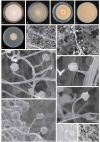Are alkalitolerant fungi of the Emericellopsis lineage (Bionectriaceae) of marine origin?
- PMID: 24563834
- PMCID: PMC3905940
- DOI: 10.5598/imafungus.2013.04.02.07
Are alkalitolerant fungi of the Emericellopsis lineage (Bionectriaceae) of marine origin?
Abstract
Surveying the fungi of alkaline soils in Siberia, Trans-Baikal regions (Russia), the Aral lake (Kazakhstan), and Eastern Mongolia, we report an abundance of alkalitolerant species representing the Emericellopsis-clade within the Acremonium cluster of fungi (order Hypocreales). On an alkaline medium (pH ca. 10), 34 acremonium-like fungal strains were obtained. One of these was able to develop a sexual morph and was shown to be a new member of the genus Emericellopsis, described here as E. alkalina sp. nov. Previous studies showed two distinct ecological clades within Emericellopsis, one consisting of terrestrial isolates and one predominantly marine. Remarkably, all the isolates from our study sites show high phylogenetic similarity based on six loci (LSU and SSU rDNA, RPB2, TEF1-α, β-tub and ITS region), regardless of their provenance within a broad geographical distribution. They group within the known marine-origin species, a finding that provides a possible link to the evolution of the alkaliphilic trait in the Emericellopsis lineage. We tested the capacities of all newly isolated strains, and the few available reference ex-type cultures, to grow over wide pH ranges. The growth performance varied among the tested isolates, which showed differences in growth rate as well as in pH preference. Whereas every newly isolated strain from soda soils was extremely alkalitolerant and displayed the ability to grow over a wide range of ambient pH (range 4-11.2), reference marine-borne and terrestrial strains showed moderate and no alkalitolerance, respectively. The growth pattern of the alkalitolerant Emericellopsis isolates was unlike that of the recently described and taxonomically unrelated alkaliphilic Sodiomyces alkalinus, obtained from the same type of soils but which showed a narrower preference towards high pH.
Keywords: Acremonium; Emericellopsis; alkaline soils; molecular phylogeny; pH tolerance; soda soils.
Figures





References
-
- Backus MP, Orpurt PA. (1961) A new Emericellopsis from Wisconsin, with notes on other species. Mycologia 53(1): 64–83
-
- Batra LR, Batra SWT, Bohart GE. (1973) The mycoflora of domesticated and wild bees (Apoidea). Mycopathologia et Mycologia applicata 49: 13–44
-
- Belyakova LA. (1970) Novij vid roda Emericellopsis (Euroticaeae). Mikologiya i Fitopatologiya 4: 530–531 [In Russian.]
-
- Belyakova LA. (1974) Rod Emericellopsis van Beyma (Eurotiaceae). Mikologiya i Fitopatologiya 8: 385–395 [In Russian.]
-
- Buchalo AS, Wasser SP, Nevo E. (2009) Fungi in saline water bodies with special attention to the hypersaline Dead Sea mycobiota. In: Fungi from Different Environments (Misra JK, Deshmukh SK, eds): 56–80 Enfield, NH: Science Publishers
LinkOut - more resources
Full Text Sources
Other Literature Sources
Molecular Biology Databases
